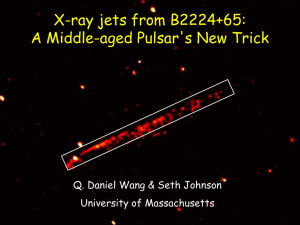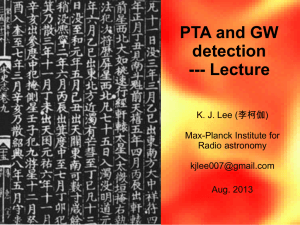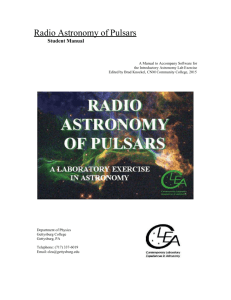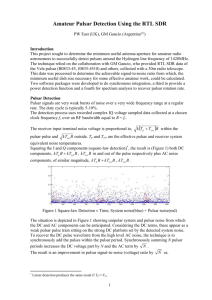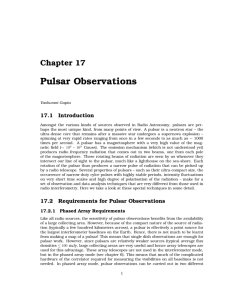elluminate_session3
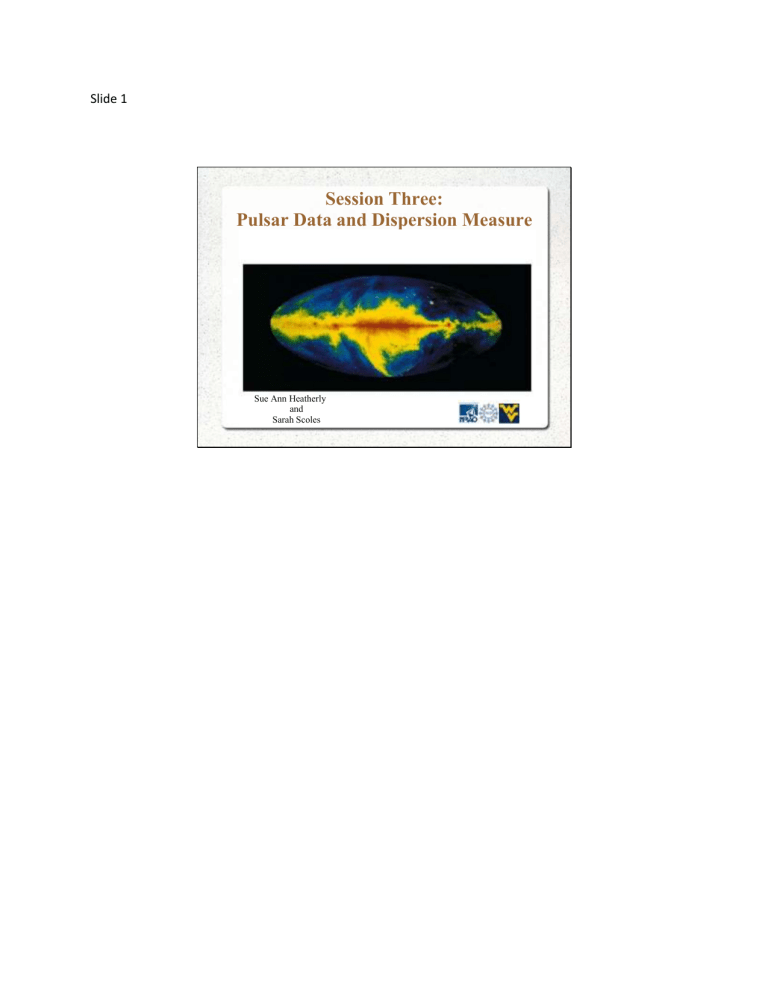
Slide 1
Session Three:
Pulsar Data and Dispersion Measure
Sue Ann Heatherly and
Sarah Scoles
Slide 2
Plot Review
Average pulse profile
Time domain
Reduced χ 2
Recall that last week, we learned about three of the subplots: the average (or integrated) pulse profile, the time domain subplot, and the reduced chi-squared subplot. The software (PRESTO) wants to find periodic, or repeating, signals in the data, but it doesn’t know what their periods are. For each pointing of the telescope, PRESTO guesses many different periods and chooses the thirty periods that look best and makes one of these plots.
The average pulse profile is created by “folding” the data at the guessed period, so that if there is a signal that repeats at that period, the signals from the whole observation will add together to create a stronger-looking signal that rises above the noise and looks like a pulse. The average pulse profile is plotted twice.
The time domain subplot shows at what part of the rotation we receive signal. Phase is on the xaxis, and time is on the y-axis. Phase is a measure of rotation, where 0 is the beginning of a rotation, 0.5 is 180 degrees of rotation from the starting point, and 1 is 360 degrees, or a full rotation. We want to see a vertical line, which means that we are receiving signal at the same point in the object’s rotation (in the case of a pulsar, this would mean that is when its magnetic pole is pointed toward us).
The reduced chi-squared subplot shows how much the data do or do not look like noise. When reduced chi-squared is 1 that means the data look exactly like noise. The higher RCS gets, the less it looks like noise. Since “fraction of observation” is the other axis of this graph, as the observation gets further and further along, and our data is folded more and more, we want our signal to look less and less like noise, so we want the RCS to get larger.
Slide 3
CLEA Homework: Questions
1.How is a pulsar’s period measured?
2.Does a pulsar’s period change if you observe at different frequencies?
3.Does the pulsar’s intensity change if you observe at different frequencies?
4.Does a pulse’s time of arrival change if you observe at different frequencies?
5.What is dispersion measure , and how does it relate to time of arrival?
•How is a pulsar’s period measured?
– You can find the period of a pulsar by determining the time interval between the arrival of one pulse and the arrival of the next pulse.
•Does a pulsar’s period change if you observe at different frequencies?
–
The period of a pulsar is independent of the frequency at which you observe. Pulsars are very stable objects with very reliable periods.
•Does the pulsar’s intensity change if you observe at different frequencies?
– A pulsar’s emission is stronger at lower frequencies. As you observe higher and higher frequencies, the pulsar becomes less and less intense. That’s why astronomers chose to do the GBT drift scan at 350 Mhz—so they could catch pulsars at their sbrightest.
•Does a pulse’s time of arrival change if you observe at different frequencies?
–
The lower the frequency, the later the pulse arrives at the telescope. If you look at the time a pulse arrives at 1400 MHz in CLEA, that time is considerably earlier than it does at 400 MHz. Even though the pulse leaves the pulsar all at once—as a distinct, sharp pulse across many frequencies— it does not arrive on Earth all at once, but over an amount of time.
•What is dispersion measure , and how does it relate to time of arrival?
– The next slide covers dispersion measure in more detail, but, in short, it represents how much we have to correct for the effect described in the previous question.
Slide 4
Dispersion Measure
• Low frequencies take longer to get here than high frequencies because of interactions with electrons
• The pulses appear smeared out over time
• Dispersion measure tells us how “smeared” the pulse is
As you know, pulsars are located far away from us, and their radio waves must travel through many light-years of space to get to us and our telescopes. That space, however, is not truly empty, though we tend to think of it that way. The space between stars—also known as the “interstellar medium” contains a lot of electrons. When radio waves, such as those from a pulsar, encounter these electrons, the two interact. This interaction causes the radio waves to be delayed. If all the radio waves were delayed by the exact same amount, that would not be a big deal. However, low-frequency waves are delayed more than high-frequency waves.
So all the frequencies of pulsar’s emission leave the pulsar itself
at the same time , but they arrive on Earth at different times
: the lower a wave’s frequency, the more its arrival on Earth is delayed. Because of this effect, the pulses we receive are “smeared” over a period of time, like the pulses in the picture above, instead of being straight lines. You can see that instead of getting signal from the pulsar all at once (which would result in a straight vertical line), we get signal from the higher frequencies first, and as time goes on, we get signal from the lower frequencies.
This smearing makes it more difficult to detect the pulses. But, if we know how smeared a pulse is, we can correct it and detect the pulse. Dispersion measure tells us how much correction we need to do to line the pulse back up. The higher the DM, the more the pulse was smeared. The more the pulse was smeared, the greater the signal path through free electrons. So, DM can be thought of as a measurement of distance—the higher the DM, the farther the pulse traveled—but that’s a rough estimate, because some parts of the galaxy have more electrons than others.
Slide 5
The DM plot
If radio waves are coming from the same object in space, we expect them to have gone through the same parts of space, meaning that they would have interacted with the same number of electrons. For this reason, if a signal comes from a pulsar, we expect it to have a distinct DM.
Like the PRESTO software guesses thousands of periods, it also guesses a bunch of DMs. It determines how well they fit the data—how well they un-smear the pulse. The DM plot takes all the DMs that the PRESTO software guessed and tells you which is the most likely. The better a
DM un-smears the data, the higher the reduced chi-squared.
In the DM plot, we’re looking for a bell curve-like peak. The top of the peak represents the DM that best un-smears the data, and as you deviate farther (on each side) from the peak, the DM unsmears less and less well.
A DM that peaks at 0 means the signal didn’t go through any electrons to get to the telescope, which means that the signal did not travel through space, which means it must have come from
Earth.
A DM subplot that does not have a peak means that the signal isn’t coming from a distinct point in space, which means it cannot be a pulsar.
Slide 6
What makes a DM “reasonable”?
1.
Not so large that the pulsar would be located outside the Milky Way
2.
Not so small that the pulsar would be located on Earth
For the plot in the previous slide:
“For Galactic longitude 235.0 degrees and latitude
13.3 degrees, and a dispersion measure of 41.0 cm -3 pc, the estimated distance to your source is 2.0 kpc.
The maximum DM predicted by the model for this direction is 97.7 cm -3 pc.”
The “DM checker” on the website tells you whether or not the DM (the one in the header and at the peak of the DM subplot) is reasonable for a pulsar at the RA and Dec listed on the plot.
Every direction from Earth into space—every pointing of the telescope—goes through a slightly different part of our galaxy, and all those different parts have different densities of electrons.
Astronomers, however, have made measurements of the electron density in all directions in the
Milky Way.
When you put in the RA and Dec on your plot, the DM checker calculates where that is in the galaxy (in galactic coordinates) and finds out what the electron density is in that direction. You also put in the DM from your plot. You’re telling it where the telescope was pointed and how much un-smearing the pulses needed. Since it knows the electron density, it calculates how far a pulse would have had to go—in an interstellar medium what that electron density—to need that much un-smearing. That’s how it gets the “estimated distance to your source.” This distance needs to still put the pulsar inside the Milky Way.
The DM checker also gives you another piece of information: the maximum DM predicted.
Since it knows how far away the edge of the galaxy is, and it knows how dense the electrons are, it can calculate the most un-smearing that a pulsar should need if it is located in this direction in the Milky Way. You want the DM listed on your plot to be below this maximum number.
Slide 7
The Sub-band plot
Although we observe with the 350 MHz receiver, that is not the only frequency we detect. The receiver observes a range of frequencies at once, and 350 MHz is just the center frequency. The range of frequencies is called the receiver’s “bandwidth.”
The bandwidth is divided into 32 sub-bands. The sub-band plot shows how signal strength relates to frequency. As you learned from your homework, pulsars are stronger at lower frequencies, so intensity does vary depending on what frequency you observe. However, the frequency differences within a single receiver are not large enough for this effect to make a large difference, and we know that pulsars are always supposed to emit some signal across a broad range of frequencies.
Thus, in this plot, we are looking to see if our candidate emits radio waves at all frequencies, or only at a few. If a signal appears in only one sub-band (which would appear as a horizontal line), that means the signal is RFI. This kind of signal is called “narrow-band.” Pulsars are “broadband” and will show vertical lines in this plot.
Slide 8
The P and P-dot plots
This part of the plot is not very useful to us because the observations of each point in the sky are very short – only 150 seconds. But just so you know: the top graph represents the slow down rate of the pulsar (p-dot) vs reduced Chi-squared, and the one below it plots the period vs reduced Chi-squared. These plots show how well we have measured the rate of change of the period and the period respectively. You should see nice sharp peaks
The color graph at the bottom plots both of these properties together. The Period and Period-dot are on the x- and y-axes, and the Reduced Chi-squared is represented by the different colors.



